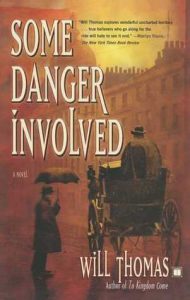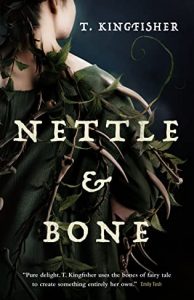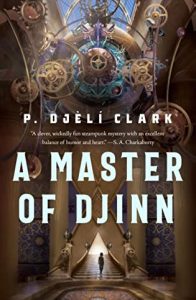 Anatomy of Evil (Barker & Llewelyn, #7) by Will Thomas
Anatomy of Evil (Barker & Llewelyn, #7) by Will Thomas Format: eARC
Source: purchased from Amazon, supplied by publisher via Edelweiss
Formats available: hardcover, paperback, ebook, audiobook
Genres: historical fiction, historical mystery
Series: Barker & Llewelyn #7
Pages: 327
Published by Minotaur Books on May 12, 2015
Purchasing Info: Author's Website, Publisher's Website, Amazon, Barnes & Noble, Kobo, Bookshop.org, Better World Books
Goodreads
In London of 1888, Private Enquiry Agent Cyrus Barker takes on his biggest case ever—the attempt to find and stop the killer terrorizing Whitechapel: Jack the Ripper
Cyrus Barker is undoubtedly England’s premiere private enquiry agent. With the help of his assistant Thomas Llewelyn, he’s developed an enviable reputation for discreetly solving some of the toughest, most consequential cases in recent history. But one evening in 1888, Robert Anderson, the head of Scotland Yard’s Criminal Investigation Department (CID), appears at Barker’s office with an offer. A series of murders in the Whitechapel area of London are turning the city upside down, with tremendous pressure being brought to bear on Scotland Yard and the government itself.
Barker is to be named temporary envoy to the Royal Family with regard to the case while surreptitiously bringing his investigative skill to the case. With various elements of society, high and low, bringing their own agenda to increasingly shocking murders, Barker and Llewellyn must find and hunt down the century’s most notorious killer. The Whitechapel Killer has managed to elude the finest minds of Scotland Yard—and beyond—he’s never faced a mind as nimble and a man as skilled as Cyrus Barker. But even Barker’s prodigious skills may not be enough to track down a killer in time.
My Review:
 Private Inquiry Agents Cyrus Barker and Thomas Llewelyn have been on a collision course with this particular date with destiny since the very first book in this series, Some Danger Involved, opened in 1884 with Barker taking Llewellyn on as his apprentice.
Private Inquiry Agents Cyrus Barker and Thomas Llewelyn have been on a collision course with this particular date with destiny since the very first book in this series, Some Danger Involved, opened in 1884 with Barker taking Llewellyn on as his apprentice.
This seventh book in the utterly riveting series of their adventures has reached the ominous year of 1888, the year that “Jack the Ripper” terrorized the streets of London’s most desperate and notorious neighborhood, Whitechapel.
Every single police agency – and there were plenty of competing jurisdictions and agencies in London in the autumn of 1888 – wanted the glory that would come from catching the killer – and zealously guarded their patch and every single scrap of evidence they managed to acquire.
In this compelling take on the investigation into the Whitechapel Murders, Scotland Yard, reluctantly and with a ridiculous number of caveats and restrictions, deputized Cyrus Barker and his apprentice-turned-assistant Thomas Llewellyn into the Metropolitan Police Department in order to avail themselves of Barker’s much vaunted expertise in investigation and manhunting.
And, in all probability, if all else failed, to have him on hand to use as a scapegoat if they couldn’t manage to close the case.
Which, or so history tells us, they didn’t. Unless one of the many conspiracy theories had it right after all, and the truth would have lit a powder keg that Scotland Yard was incapable of putting out.
Escape Rating A+: I picked this book when I did because I was on a long flight and needed something that was guaranteed to take me away from my current circumstances. I was one hundred percent certain that Barker & Llewelyn were the men for the job.
Which they absolutely were.
The fascinating thing about this particular entry in this long-running series is that its focus isn’t on the lurid details of the crimes, but rather on the intricate details of the investigation – including the interdepartmental rivalries, the political shenanigans, the conflicting social mores of the time and the various factions that needed protection – or demanded it – as well as the potential consequences of any of the various possible resolutions.
Barker and Llewelyn find themselves in the one place neither of them ever expected to be. They’re not just in the thick of the investigation, but they are embedded firmly into the Metropolitan Police. Barker prefers to be his own boss and run his own show, and Llewelyn is an ex-con. While neither of them expected to be welcomed in the Met with open arms, they’re continually astonished that they are there at all.
At the same time, the experience fosters respect on both sides that honestly neither side believed was possible. It will be interesting to see how and even whether that continues in future stories.
But the Ripper killings took place at the dawn of forensic science – and many of the techniques were still being hotly debated – even as “Jack” cut a bloody swath through Whitechapel and left damned few clues behind him – while the gutter press did their damndest to gin up readership with sensationalism.
The story runs at a compelling, page-turning pace as Barker and Llewelyn gather and discard clues and theories even as they walk the streets of Whitechapel night after night in an attempt to learn the territory so they can spot anything out of place – while they observe the day-to-day and night-to-night life of this district that most well-heeled Londoners would just as soon forget with understanding and empathy instead of the judgment and derision exhibited by their current colleagues and their usual clientele.
 In the end, Barker gets his man – with Llewelyn’s able assistance – just as he always does. That the solution seems plausible even though justice can’t truly be served feels right, true to the circumstances, and even surprisingly satisfactory – in spite of the lack of historical closure.
In the end, Barker gets his man – with Llewelyn’s able assistance – just as he always does. That the solution seems plausible even though justice can’t truly be served feels right, true to the circumstances, and even surprisingly satisfactory – in spite of the lack of historical closure.
Saying that I had a “good” reading time with Barker & Llewelyn this time around feels wrong – because the whole Ripper case is awful. I appreciated the way that the story dealt with the evidence of the actual killings without sensationalizing them more than has already been done elsewhere and plenty. The in-depth details, very much on the other hand, of the investigative processes of the police and the sheer amount of manpower they devoted to the case were fascinating.
And of course, I love these characters, so taking them out of their familiar haunts and watching them still get the job done added new layers to them, their association and their story. Which means that I will definitely continue my journey with Barker & Llewelyn with the next book in the series, Hell Bay, the next time I need to be swept away to Victorian London.

 New Adventures in Space Opera by
New Adventures in Space Opera by  Time's Agent by
Time's Agent by  Lady Macbeth by
Lady Macbeth by 
 (If you’re wondering – as I was – it reminds me of
(If you’re wondering – as I was – it reminds me of  A Sorceress Comes to Call by
A Sorceress Comes to Call by  Escape Rating A+: This wasn’t what I expected, although having read quite a bit of the author’s work, I probably should have.
Escape Rating A+: This wasn’t what I expected, although having read quite a bit of the author’s work, I probably should have.  Which is when I felt like I got hit with a clue-by-four, to the point of chagrin that I didn’t figure out a whole bunch of things sooner. Not the way that Hester got the best of the sorceress, but rather the way that the story as a whole worked. And, as I mulled things over more than a bit, the way that
Which is when I felt like I got hit with a clue-by-four, to the point of chagrin that I didn’t figure out a whole bunch of things sooner. Not the way that Hester got the best of the sorceress, but rather the way that the story as a whole worked. And, as I mulled things over more than a bit, the way that  The Dead Cat Tail Assassins by
The Dead Cat Tail Assassins by  Escape Rating A+: I picked this up because I adored the author’s
Escape Rating A+: I picked this up because I adored the author’s  Navigational Entanglements by
Navigational Entanglements by  Escape Rating A-: I grabbed this book because I’ve been picking my way through the author’s vast, sprawling,
Escape Rating A-: I grabbed this book because I’ve been picking my way through the author’s vast, sprawling,  The Nightingale's Castle by
The Nightingale's Castle by 
 In the Shadow of the Fall (Guardians of the Gods, #1) by
In the Shadow of the Fall (Guardians of the Gods, #1) by  Something which I’m sure is intended to happen in the second book in the duology,
Something which I’m sure is intended to happen in the second book in the duology,  More Days at the Morisaki Bookshop (Days at the Morisaki Bookshop, #2) by
More Days at the Morisaki Bookshop (Days at the Morisaki Bookshop, #2) by  Escape Rating A-: I picked up More Days at the Morisaki Bookshop because, having fallen in love with the first book,
Escape Rating A-: I picked up More Days at the Morisaki Bookshop because, having fallen in love with the first book,  So maybe don’t listen to that part while you’re driving because the urge to cry right along with Takako is pretty much irresistible.
So maybe don’t listen to that part while you’re driving because the urge to cry right along with Takako is pretty much irresistible.